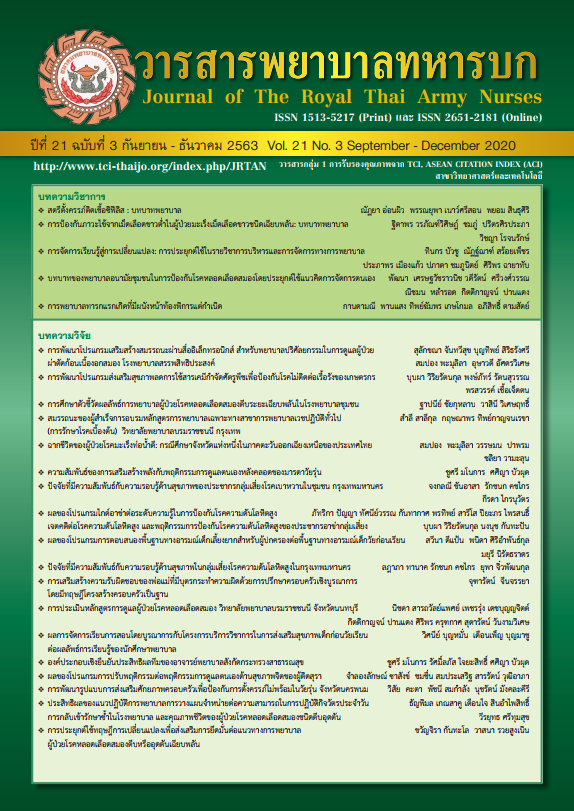The Effectiveness of Discharge Planning’s Clinical Nursing Practice Guideline on Activity Daily Livings, Hospital Readmission and Quality of Life in Ischemic Stroke Patients
Keywords:
discharge planning, activity daily livings, hospital readmission, quality of life, ischemic strokeAbstract
This quasi-experimental research aimed to study the effectiveness of discharge planning’s clinical nursing practice guideline on activity daily livings, hospital readmission and quality of life in ischemic stroke patients. The samples were divided into two groups: including 30 patients received usual care, and 30 patients received discharge planning’s clinical nursing practice guideline. Data analyzed using frequency, percentage, average score, standard deviation, and t-test statistics. The results found that the average age of ischemic stroke patients in the intervention group was 59 years old, most of participants were male with 56.7 percent, and married status was 80 percent. The participants in the intervention group showed activity daily livings and quality of life average scores after implementing the discharge planning intervention higher than the control group with significant difference (t40 = -2.629, p = .012 and t58 = -2.481, p = .016, respectively). However, hospital readmission of ischemic stroke patients found 2 cases while no hospital readmission was found in the intervention group after a 1-month follow-up but no significant difference (p = .150). Therefore, to develop the outcomes in taking care of ischemic stroke patients, nurses must have the appropriate and effective discharge planning’s clinical nursing practice guideline.
Downloads
References
Kommarg U, Sindhu S. Time to treatment with intravenous recombinant tissue plasminogen activator to the neurological recovery in patients with acute ischemic stroke at Thammasat university hospital. Journal of the Royal Thai Army Nurses. 2015; 16(2): 106-113. (in Thai)
Division of non-communicable diseases, Department of disease control. Ministry of public health. Reported number and rate of inpatients with stroke. Bangkok: The printing office to assist veterans organization; 2012. (in Thai)
Ali ZH. Effect of nursing care strategy on the functional and physical abilities of patients following stroke. Journal neurology and neurophysiology. 2013; 8(6): S8.
Wokleah H. Factors influencing to health-related quality of life among stroke survivors of Yala hospital (thesis). Yala: Yala rajabhat university; 2016. (in Thai)
Ghandour AM. Multicenter assessment of health-related quality of life (HRQOL) among stroke survivors. Archivos de medicina. 2016; 7(3): 96.
Singkham N, Denwannakul W, Oa-sot J, Talodthaisong M, Maneejun R, Jenghua K. Predictors of hospital readmission among stroke patients. Naresuan Phayao Journal. 2017; 10(3): 87-89. (in Thai)
Sereewichayasawad N, Maneewong P, Srisuk O, Phongoen N, Neelapaichit N. Factors related to hospital readmission among stroke patient in home health care unit. Journal of public health nursing. 2014; 28(3): 30-40. (in Thai)
Siritham N, Tiamkao S. Causes and risk factors of recurrent thrombotic stroke in srinagarind hospital. I-San journal of internal medicine. 2552; 5(3): 154-175. (in Thai)
Kongkiatpan N. Development of discharge planning guideline for elderly with cerebrovascular disease at Kosumphisai hospital, Mahasarakham province. Master of Nursing in gerontological nursing. Faculty of nursing, Burapha university, 2013. (in Thai)
Satitpan C. The nursing management of discharge planning program for stroke patients at the tertiary level hospital in Suphanburi province. Master of nursing science program, nursing management program. Christian university of Thailand, 2012. (in Thai)
Hattacho Y. Effects of discharge planning program on knowledge and activities of daily living of stroke patients in stroke unit Udonthani hospital. Udonthani hospital medical journal. 2017; 25(2): 136-142. (in Thai)
Bamrungpun A, Ampon K, Sinkitcharoen P. The effect of using the pre-discharge preparation model on professional nurses’ awareness of professional nurse responsibility and quality of life level of stroke patients, Phrapokklao hospital. Journal of nursing division. 2010; 37(3): 1-14. (in Thai)
Prasat neurological institute, Department of medical services, Ministry of public health. Medical records and statistics. Bangkok: Medical record department; 2020. (in Thai)
McKeehan KM. Conceptual framework for discharge planning. In continuing care: A multidisciplinary approach to discharge planning. St. Louis: The CV Mosby Co., Ltd; 1981.
Nursing division. Ministry of public health. Patient discharge planning model. Nonthaburi: Ministry of public health; 2014. (in Thai)
Cohen J. Statistical power analysis for the behavioral sciences. New York: Routledge academic; 1988.
Buapin C, Julamad P, Pisitpitatana N. Effects of a clinical nursing practice guideline for discharge planning on the quality of life of elderly stroke survivors. The southern college network journal of nursing and public health. 2019; 6(1): 51-62. (in Thai)
Puanfai S, Wongcharoen S, Maneeratana N, Waraporn K. Effectiveness of transitional care program on activities of daily living and quality of life among elderly with stroke at Chiangmai neurological hospital, Chiangmai province, Thailand. Journal of health science. 2018; 27: 500-509. (in Thai)
Utthiya P. Role of home care nurses for older adults with end stage cancer. Journal of the Royal Thai Army Nurses. 2020; 21(1): 18-25. (in Thai)
Downloads
Published
How to Cite
Issue
Section
License
บทความหรือข้อคิดเห็นใดใดที่ปรากฏในวารสารพยาบาลทหารบกเป็นวรรณกรรมของผู้เขียน ซึ่งบรรณาธิการหรือสมาคมพยาบาลทหารบก ไม่จำเป็นต้องเห็นด้วย
บทความที่ได้รับการตีพิมพ์เป็นลิขสิทธิ์ของวารสารพยาบาลทหารบก
The ideas and opinions expressed in the Journal of The Royal Thai Army Nurses are those of the authors and not necessarily those
of the editor or Royal Thai Army Nurses Association.






